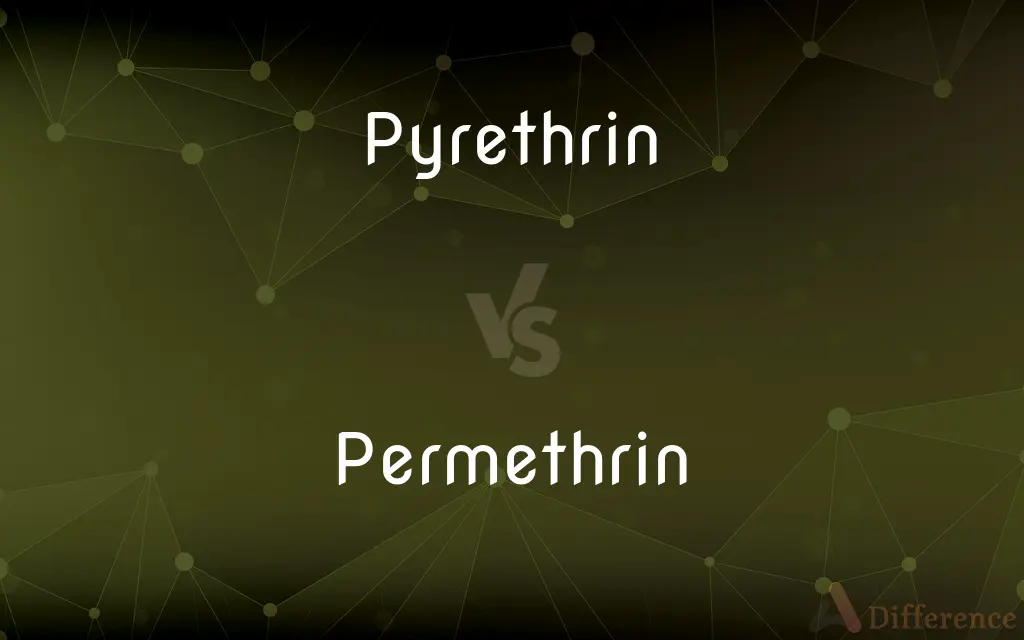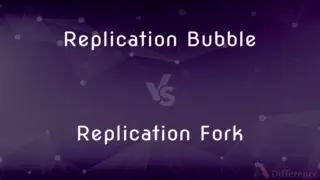Pyrethrin vs. Permethrin — What's the Difference?
By Tayyaba Rehman — Published on January 7, 2024
Pyrethrin is a natural insecticide derived from chrysanthemum flowers, while permethrin is a synthetic chemical similar to pyrethrin, used as an insect repellent and insecticide.

Difference Between Pyrethrin and Permethrin
Table of Contents
ADVERTISEMENT
Key Differences
Pyrethrin is an organic compound naturally derived from chrysanthemum flowers, specifically Chrysanthemum cinerariifolium. It is used as an insecticide and has a rapid knockdown effect on insects. Permethrin, on the other hand, is a synthetic chemical that mimics the structure and insecticidal properties of pyrethrin. It is more stable and longer-lasting than pyrethrin, making it suitable for prolonged insect control.
The mode of action of pyrethrin involves attacking the nervous systems of insects, leading to paralysis and death. This action is fast but not long-lasting, as pyrethrin degrades quickly in the environment, particularly in sunlight. Permethrin also affects the nervous system but is more persistent in the environment, providing extended control against insects.
Pyrethrin is commonly used in household insecticides and is preferred for organic farming due to its natural origin and rapid degradation. Permethrin is widely used in agriculture, textile industry (like impregnated clothing), and public health for controlling a wide range of insects, including mosquitoes, ticks, and fleas.
Regarding safety, pyrethrin is considered low in toxicity to mammals and birds but is highly toxic to fish and beneficial insects like bees. Permethrin, while also low in mammalian toxicity, has raised concerns due to its longer environmental persistence and potential impact on non-target species.
In application, pyrethrin is often used for immediate insect control, especially where environmental impact is a concern. Permethrin, due to its stability, is chosen for situations where lasting protection is needed, such as in tick and mosquito repellents, and in treating clothing and gear for outdoor activities.
ADVERTISEMENT
Comparison Chart
Origin
Natural, from chrysanthemum flowers
Synthetic, man-made chemical
Stability
Degradable, less stable in environment
More stable and persistent in environment
Usage
Household insecticides, organic farming
Agriculture, public health, textile industry
Environmental Impact
Low persistence, high toxicity to aquatic life
Longer persistence, concerns for non-target species
Application
Immediate insect control
Long-lasting protection, insect repellent
Compare with Definitions
Pyrethrin
Natural insecticide
Pyrethrin is used in garden sprays to control pests.
Permethrin
Mimics natural pyrethrin
Permethrin is designed to be like natural pyrethrin.
Pyrethrin
Biodegradable
Pyrethrin breaks down rapidly in sunlight.
Permethrin
Synthetic insecticide
Permethrin is used in agricultural pest control.
Pyrethrin
Derived from flowers
Pyrethrin is extracted from chrysanthemum flowers.
Permethrin
Long-lasting protection
Permethrin-treated clothing repels ticks and mosquitoes.
Pyrethrin
Used in organic farming
Organic farmers often choose pyrethrin for pest control.
Permethrin
Used in public health
Permethrin is applied in mosquito control programs.
Pyrethrin
Rapid knockdown effect
Pyrethrin quickly incapacitates flying insects.
Permethrin
Stable in environment
Permethrin remains effective for weeks after application.
Pyrethrin
Either of two viscous liquid esters, C21H28O3 or C22H28O5, that are extracted from pyrethrum flowers and used as insecticides.
Permethrin
A synthetic pyrethroid, C21H20Cl2O3, used as an agricultural, industrial, and residential insecticide, to treat scabies and head lice in humans, and to control fleas and ticks in dogs.
Pyrethrin
(organic compound) Any of a number of naturally occurring insecticides extracted from the pyrethrum plant; unusual in having a cyclopropane ring.
Permethrin
A synthetic insecticide, C21H20Cl2O3, used to treat head lice, nits, scabies, and in flea collars.
Pyrethrin
A substance resembling, and isomeric with, ordinary camphor, and extracted from the essential oil of feverfew; - called also Pyrethrum camphor.
Common Curiosities
Does pyrethrin affect bees?
Yes, it's toxic to bees and other beneficial insects.
Can permethrin be applied to clothing?
Yes, it's used to treat clothing for protection against ticks and mosquitoes.
Is pyrethrin environmentally friendly?
It's considered eco-friendly due to its rapid degradation, but it's toxic to aquatic life.
Is pyrethrin safe for indoor use?
Yes, it's commonly used in household insecticides.
Is permethrin safe for pets?
Yes, but it should be used as directed, especially around cats.
Can pyrethrin be used in organic farming?
Yes, it's approved for use in organic agriculture.
How quickly does pyrethrin work?
It acts quickly to knock down and kill insects.
Is pyrethrin harmful to humans?
It's generally safe, but can cause allergic reactions in some people.
Can permethrin be used on crops?
Yes, it's widely used in agricultural pest control.
Does permethrin repel or kill insects?
It both repels and kills a variety of insects.
Can permethrin be washed off easily?
It binds tightly to fabric, making it resistant to washing.
How long does permethrin last?
It can remain effective for several weeks.
Are there resistance issues with pyrethrin?
Some insects can develop resistance to pyrethrin.
Is permethrin effective against all pests?
It's effective against many, but not all pests.
Can pyrethrin be used in water bodies for mosquito control?
No, it's highly toxic to fish and should not be used in aquatic environments.
Share Your Discovery

Previous Comparison
Naive vs. Stupid
Next Comparison
Replication Bubble vs. Replication ForkAuthor Spotlight
Written by
Tayyaba RehmanTayyaba Rehman is a distinguished writer, currently serving as a primary contributor to askdifference.com. As a researcher in semantics and etymology, Tayyaba's passion for the complexity of languages and their distinctions has found a perfect home on the platform. Tayyaba delves into the intricacies of language, distinguishing between commonly confused words and phrases, thereby providing clarity for readers worldwide.











































